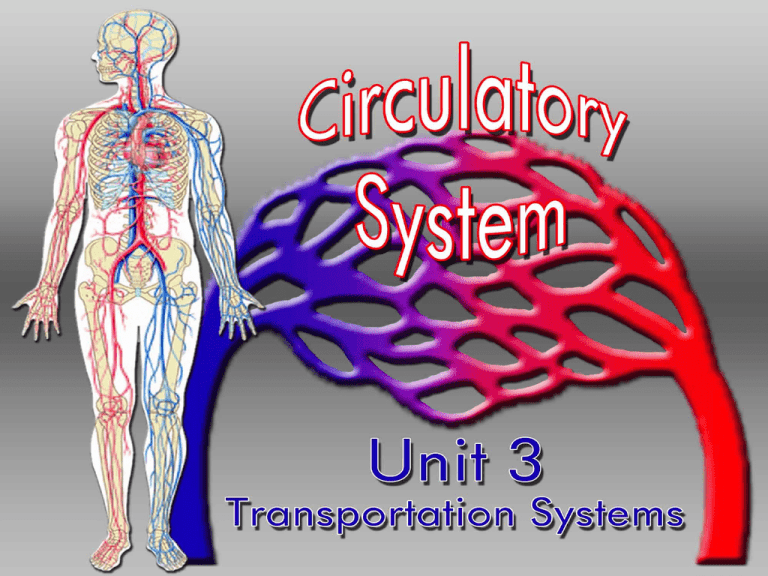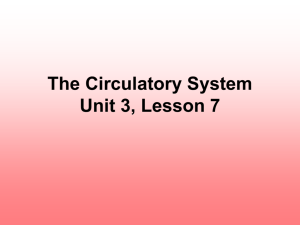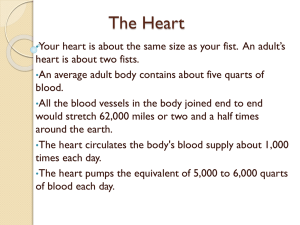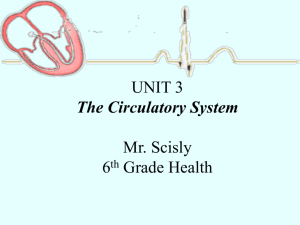The CIRCULATORY System Unit 3 Transportation Systems
advertisement

The CIRCULATORY System Unit 3 Transportation Systems The Circulatory System Functions of the Circulatory System • Transports nutrients and waste. – Arteries pick up nutrients and deliver the nutrients to each body cell. – Veins carry away waste products and excess fluid of each body cell. Functions of the Circulatory System • Transports heat. – Regulates heat by distributing heat generated by muscles. • Transports oxygen to body cells and carbon dioxide away from body cells. – Arteries carry oxygen to cells. – Veins take carbon dioxide away from cells. Functions of the Circulatory System • Transports hormones through the blood stream. • Transports antibodies. – Through the blood stream to help the body fight infection. Structures of the Circulatory System Blood • Provides vital transportation for the body • Four components – Red blood cells (erythrocytes) – White blood cells (leukocytes) – Platelets (thrombocytes) – Plasma What’s in your blood anyway? • Plasma (55% of blood volume) – Mostly water – Dissolved ions- K+, Na+, Ca+, Mg+, Cl-, bicarbonate – Proteins- fibrinogen, immunoglobulins, albumin – Transported substances- digested nutrients, wastes, gases, hormones Cells in your blood • Red blood cells – erythrocytes – 25 trillion in your body – No nucleus or mitochondria – Contain hemoglobin • Each can carry a billion oxygen molecules Cells in your blood • White blood cells – leukocytes – 5-10 thousand – Fight off infective invaders, produce immunity – 5 main types • Monocytes and Neutrophils • Basophils • Eosinophils • Lymphocytes Cells in your blood • Platelets – Not truly a cell but a cell fragment – Help with clotting • Release clotting factors that activate fibrinogen → fibrin • Plug the hole Blood Vessels • Closed system for flow of blood • Three types of vessels: – Arteries, Capillaries, and Veins Vein Artery Valve Arterioles Venules Capillarybed Leaky Capillary Beds • • • • • Heart Hollow organ Pumps blood throughout the body Four chambers Major blood vessels Four valves The 4 Chambers of the Heart Right Atrium Left Atrium Receives unoxygenated blood from the veins. Receives oxygenated blood from the lungs and pumps it into the left ventricle. Right Ventricle Left Ventricle Receives blood from the right atrium and pumps to the lungs. Pumps blood into the aorta, which will transport blood through the body. Valves in the Heart • • • • Tricuspid Valve Pulmonary Valve Mitral (Bicuspid) Valve Aortic Valve Major Blood Vessels in the Heart • • • • • Superior Vena Cava Inferior Vena Cava Pulmonary Arteries Pulmonary Veins Aorta Superior Pulmonary Aortic Tricuspid Mitral Inferior Blood flow through the Heart • Superior & Inferior Vena Cava • Right Atrium • Tricuspid Valve • Right Ventricle • Pulmonary Semilunar Valve • Pulmonary Arteries • • • • Lungs Pulmonary Veins Left Atrium Bicuspid (Mitral) Valve • Left Ventricle • Aortic Semilunar Valve • Aorta Diseases and Disorders • Anemia • Heart Attack • High Blood Pressure • Atherosclerosis Anemia • Blood disorder where capacity of the blood to transport oxygen is decreased. • Usually red blood cell count is diminished. • Causes: – Internal bleeding, vitamin deficiencies, decreased RBC production, increase in RBC destruction by spleen • Symptoms: – Fatigue, chest pain, skin pallor, increased heart rate, difficulty breathing Heart Attack (Myocardial Infarction) • Coronary artery or a branch of the coronary artery is blocked. • Symptoms: – Chest pain – Crushing pressure behind the breastbone and chest pain radiating to the neck, jaw, abdomen, shoulder or left arm. – Nausea – Vomiting – Difficulty breathing – Anxiety or fear What is a Heart Attack? High Blood Pressure (Hypertension) • Blood pressure is chronically elevated. • Can contribute to coronary artery disease, strokes, kidney failure, and sudden rupture of the aorta. • Sustained systolic blood pressure of over 140 or a sustained diastolic blood pressure of over 90 is considered hypertension. • Usually there are no symptoms other than a mild headache. Atherosclerosis • Build-up of fatty deposits on the inner walls of arteries. • Restricts the flow of blood. • Fats and other particles combine to form plaque. • Calcium can be deposited by plaque and cause the area to harden.




